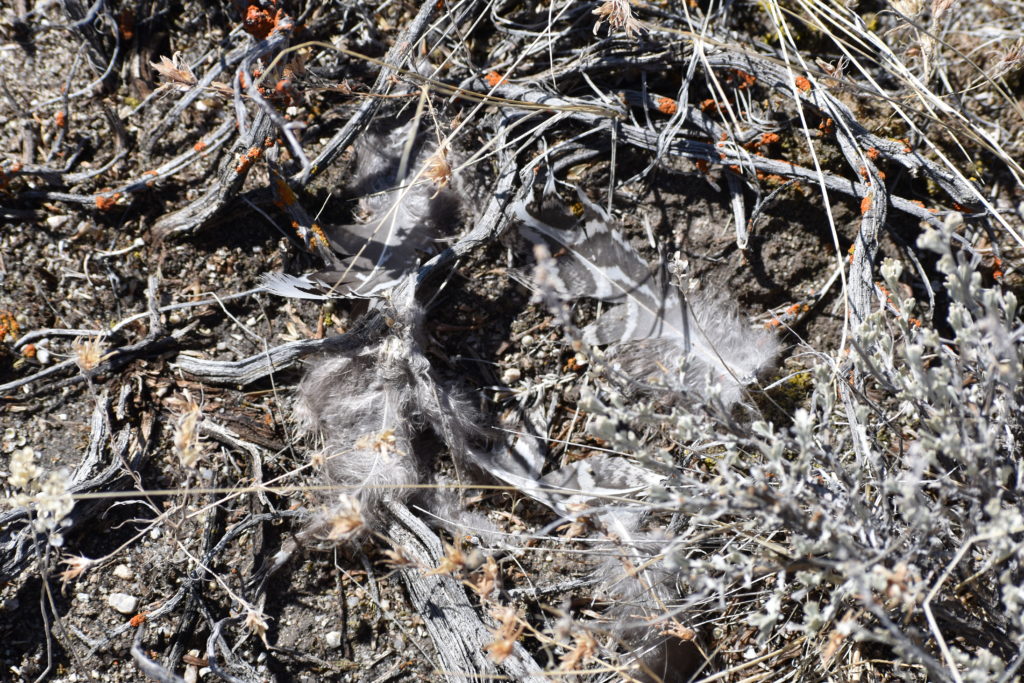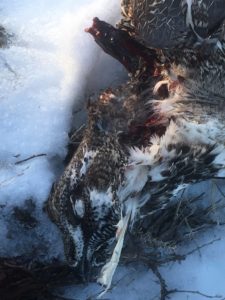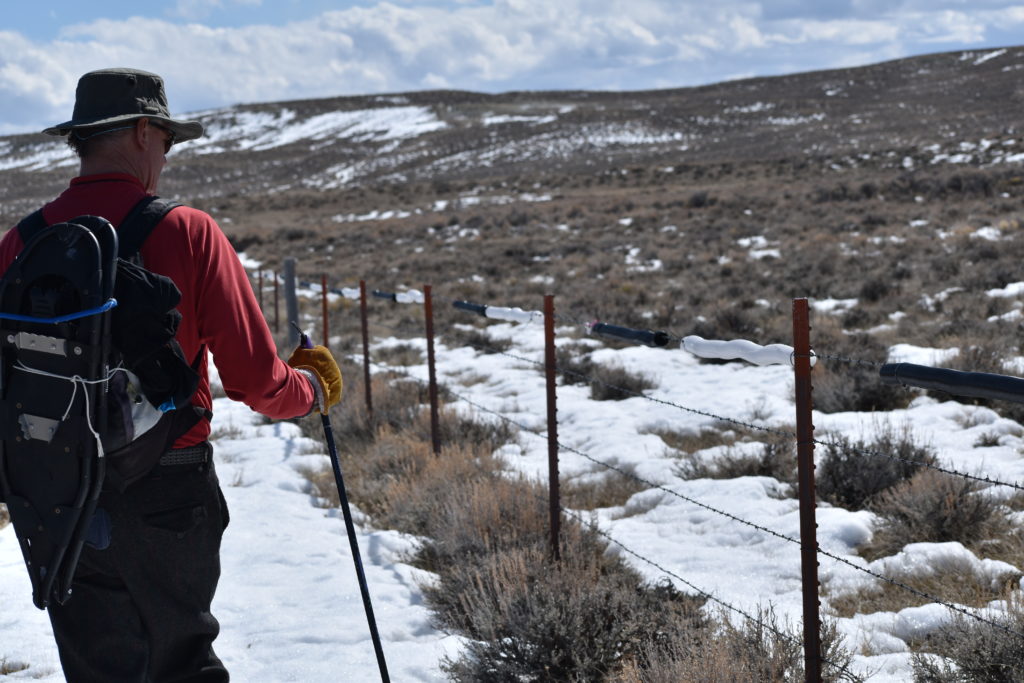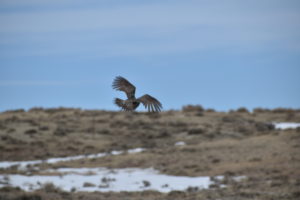By Kyle Kissock | Communications Manager

This tiny clump of feathers we found beneath a barbed-wire fence at Alkali Draw was evidence of a potential sage grouse “fence strike.”
Feathers as Clues
“I think I found a strike!” said Wes.
Beneath the fence lay a small clump of feathers – evidence, perhaps of what we’d been looking for since we’d left the trucks that morning?
The speckled down was so perfectly camouflaged with the sagebrush that I’d missed it when walking by seconds before. It was a sharp spot by Wes, who was evidently doing a better job of keeping his eyes glued to the fence line than I was.
Wes, Martin (our other volunteer) and I were surveying a two-mile long stretch of barbed-wire fence for “sage-grouse strikes” near Alkali Draw, just east of Big Piney. For the last two hours we’d waded through thigh-high sagebrush and post-holed through melting March snow drifts as we followed the fence line across the expansive open range.
We were looking for clues that would indicate the presence of a grouse strike, an unfortunate instance where a grouse collides with a barbed-wire fence in mid-flight. Strikes are more common that anyone would like in this area. While sometimes the grouse fly away unscathed, oftentimes the strike ends up being fatal, much like the fate of songbirds that slam into windows.
This smattering of feathers was the first evidence of a potential strike we’d come across that morning. Given the lengthy amount of fence we’d surveyed, finding only a single clump of feathers to this point was a good sign.

Project volunteers take field notes on the potential fence strike found on the Alkali Draw fence. The feathers were found under one of the fences we treated with black plastic loom, with the goal of making the fence’s top wire more visible to birds.
We marked our location along the fence using GPS. Although the feathers looked old (freshly melted out from under a winter’s worth of snow) we began to move outward from the feathers, methodically scanning the muddy ground for more clues that might help us determine the fate of the bird to which the clump of feathers once belonged.
The Problem: Mitigating Fence Strikes
Much of Wyoming’s whopping 43 million acres of sagebrush country serves as a refuge of sorts for the Greater Sage-Grouse.
It’s estimated that nearly 40% of the world’s Greater Sage-Grouse population occurs in the state, and perhaps no species is more inextricably linked to this specific sagebrush habitat.
But as land use has changed, Wyoming’s sage-grouse population hasn’t been exempt from dramatic declines. Over the last century the overall population of Greater Sage-Grouse in the American West has cratered nearly 95%. This is primarily due to habitat loss from human development such as farms, subdivisions, and energy infrastructure.

A victim of a fence strike. Sage-grouse most frequently collide with the top wire of barbed-wire fences, which can result in grizzly decapitations like the one pictured here.
While mortalities from fence strikes haven’t been shown to be a driving factor in the decline of grouse populations, anecdotal evidence suggests that the impacts could be significant. The fence we were surveying at Alkali Draw is one such case. It runs through an especially dense sage-grouse area, where birds flock seasonally either for mating or to forage for food.
Complicating the problem, sage-grouse are poorly adapted to recognize and avoid fences when flying. When they take to the air, grouse fly relatively low to the ground (think fence height), their wingtips nearly clipping the sagebrush.
By the time they see the fence, if they see it at all, it’s too late to react.
At Alkali Draw it’s not an uncommon sight to find signs of grouse strikes; a ball of feathers clinging to a fence, or even the full carcass of a grouse hanging on a wire if it hasn’t yet been dragged away by scavengers.
The Solution: Treatments for Fences
Back at the fence, for 10 minutes we searched the area surrounding the feathers that Wes found, but did not find additional signs of the bird that left its mark. This was to be expected as the strike was old and had it resulted in a mortality, remnants of the dead bird would likely be long gone.
Given that the feathers were found directly under the barbed-wire, we determined this was evidence of a fence strike. After making note that the feathers were found under the section of barbed-wire that we’d treated with black plastic loom, we carried down the fence line.
The Alkali Draw fence is actively used to contain livestock and cannot be permanently removed. But in seeking a solution to mitigate strikes in the area, we had applied a series of treatments to the fence that make its wires more visible to airborne grouse. The “black plastic loom” was one of the treatments we were studying.

An example of the wooden stays “treatment” applied to the fence to make it more visible to grouse. Note the visible wooden posts we installed on the wire in between the standard metal t-posts.
Last year, the Jackson Hole Wildlife Foundation partnered with the Bureau of Land Management (BLM) to apply multiple treatment types to barbed-wire fences outside of Pinedale, where grouse strikes are recurring issues.
Our goal is to conduct a long-term study over multiple seasons to explore which treatment type works best to reduce grouse strikes. Teton Raptor Center is the project’s partner responsible for crunching the data points and analyzing the effectiveness, or lack thereof, for each fence treatment.
The study design is simple; at each study site each treatment type covers roughly ¼ mile of fence and treatments are as follows:
1. Black plastic loom on the top wire
2. White plastic loom on the top wire
3. Mixed loom (black and white) on the top wire
4. Wooden “stays” installed vertically on the fence

A volunteer surveys the Alkali Draw fence for strikes in the “mixed loom” treatment section. Both black and white plastic loom has been installed on the top wire to maximize visibility in all weather conditions.
Our plan is to work with the BLM to survey five miles of fence on a bi-weekly basis through the winter and spring to record the number of strikes and mortalities that occurs in each treatment area.
At each study site we leave a portion of barbed-wire untreated as a control in the experiment. If over time, and with the help of Teton Raptor Center’s research director, we determine that there is a statistically significant difference between the amount of strikes in the control segments and our treatments, we’ll be able to recommend a preferred treatment and application to fences where high-levels of strikes are occurring.
Data collection for the 2020 season is just starting, so stay tuned for updates on what’s working and why!

